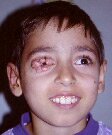| |
April 2000
Case of the Month: A 7 year old HIV-infected boy with a CD4 count of 150 cells/microliter presents to you with the periocular lesion shown in the photograph.
Answer: Giant molluscum contagiosum
 Discussion: Molluscum contagiosum is a normally benign lesion. Individual lesions usually measure 1-2 mm in diameter and have a characteristic umbilicated, pearly-white appearance. Clusters of these lesions can appear anywhere on the body. Molluscum contagiosum is caused by a poxvirus and generally resolves without therapy within 2 to 3 months in the immunocompetent child. Approximately 10% of HIV-infected individuals develop lesions which may number in the hundreds, become "giant" (greater than 1 cm), and display a predilection for the eyelids. The lesions most commonly affect the face, head, and neck and are often pruritic and may become superinfected. Ocular lesions can be sight-threatening. Treatment is unsatisfactory. Antiretroviral therapy, particularly in the early stages, is sometimes effective. While cyrotherapy and curettage may provide transient relief, the papules usually recur, and these modalities may cause cosmetic disfigurement. Cidofovir, an anti-cytomegalovirus agent, is under investigation for treatment of molluscum contagiosum. Discussion: Molluscum contagiosum is a normally benign lesion. Individual lesions usually measure 1-2 mm in diameter and have a characteristic umbilicated, pearly-white appearance. Clusters of these lesions can appear anywhere on the body. Molluscum contagiosum is caused by a poxvirus and generally resolves without therapy within 2 to 3 months in the immunocompetent child. Approximately 10% of HIV-infected individuals develop lesions which may number in the hundreds, become "giant" (greater than 1 cm), and display a predilection for the eyelids. The lesions most commonly affect the face, head, and neck and are often pruritic and may become superinfected. Ocular lesions can be sight-threatening. Treatment is unsatisfactory. Antiretroviral therapy, particularly in the early stages, is sometimes effective. While cyrotherapy and curettage may provide transient relief, the papules usually recur, and these modalities may cause cosmetic disfigurement. Cidofovir, an anti-cytomegalovirus agent, is under investigation for treatment of molluscum contagiosum.
|